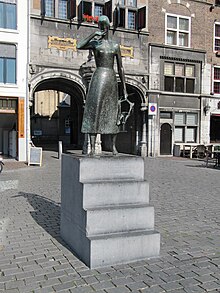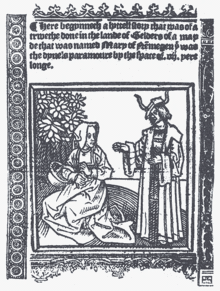This article presents lists of the literary events and publications in the 15th century.
This article presents lists of literary events and publications in the 16th century.

Till Eulenspiegel is the protagonist of a European narrative tradition. A German chapbook published around 1510 is the oldest known extant publication about the folk hero, but a background in earlier Middle Low German folklore is likely. The character may have been based on a historical person.

Valentine and Orson is a romance which has been attached to the Carolingian cycle.
Dutch language literature comprises all writings of literary merit written through the ages in the Dutch language, a language which currently has around 23 million native speakers. Dutch-language literature is the product of the Netherlands, Belgium, Suriname, the Netherlands Antilles and of formerly Dutch-speaking regions, such as French Flanders, South Africa, and Indonesia. The Dutch East Indies, as Indonesia was called under Dutch colonization, spawned a separate subsection in Dutch-language literature. Conversely, Dutch-language literature sometimes was and is produced by people originally from abroad who came to live in Dutch-speaking regions, such as Anne Frank and Kader Abdolah. In its earliest stages, Dutch-language literature is defined as those pieces of literary merit written in one of the Dutch dialects of the Low Countries. Before the 17th century, there was no unified standard language; the dialects that are considered Dutch evolved from Old Frankish. A separate Afrikaans literature started to emerge during the 19th century, and it shares the same literary roots as contemporary Dutch, as Afrikaans evolved from 17th-century Dutch. The term Dutch literature may either indicate in a narrow sense literature from the Netherlands, or alternatively Dutch-language literature.

Bevis of Hampton (Old French: Beuve(s) or Bueve or Beavisde Hanton(n)e; Anglo-Norman: Boeve de Haumtone; Italian: Buovo d'Antona) or Sir Bevois, was a legendary English hero and the subject of Anglo-Norman, Dutch, French, English, Venetian, and other medieval metrical chivalric romances that bear his name. The tale also exists in medieval prose, with translations to Romanian, Russian, Dutch, Irish, Welsh, Old Norse and Yiddish.
Apollonius of Tyre is the hero of a short ancient novel, popular in the Middle Ages. Existing in numerous forms in many languages, all are thought to derive from an ancient Greek version now lost.
Flemish literature is literature from Flanders, historically a region comprising parts of present-day Belgium, France and the Netherlands. Until the early 19th century, this literature was regarded as an integral part of Dutch literature. After Belgium became independent from the Netherlands in 1830, the term Flemish literature acquired a narrower meaning and refers to the Dutch-language literature produced in Belgium. It remains a part of Dutch-language literature.
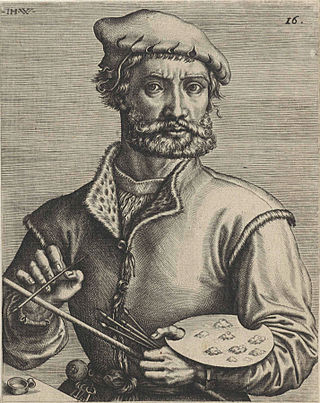
Pieter Coecke van Aelst or Pieter Coecke van Aelst the Elder was a Flemish painter, sculptor, architect, author and designer of woodcuts, goldsmith's work, stained glass and tapestries. His principal subjects were Christian religious themes. He worked in Antwerp and Brussels and was appointed court painter to Charles V, Holy Roman Emperor.
Middle Dutch literature (1150–1500) is the Dutch literature produced in the Low Countries from the 12th century to the 16th century. It is preceded by only a few fragmentary texts existing in Old Dutch, and it was succeeded by Dutch Renaissance and Golden Age literature.
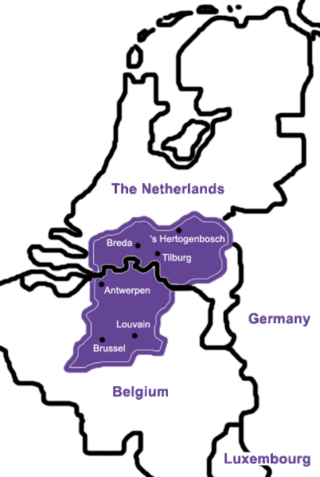
Hadewijch, sometimes referred to as Hadewych or Hadewig was a 13th-century poet and mystic, probably living in the Duchy of Brabant. Most of her extant writings are in a Brabantian form of Middle Dutch. Her writings include visions, prose letters and poetry. Hadewijch was one of the most important direct influences on John of Ruysbroeck.

Folklore of the Low Countries, often just referred to as Dutch folklore, includes the epics, legends, fairy tales and oral traditions of the people of Belgium, Netherlands and Luxembourg. Traditionally this folklore is written or spoken in Dutch or in one of the regional languages of these countries.
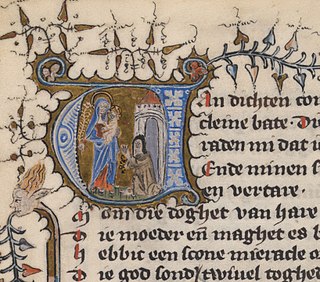
Beatrijs is a poem written in last quarter of 14th century (ca.1374), possibly by Diederic van Assenede, and is an original Dutch poem about the legend of a nun, Beatrijs, who deserted her convent for the love of a man, lives with him for seven years and has two children. When their money is low he deserts her and she becomes a prostitute to support her children for another seven years. One day she is near her old convent, so she inquires discreetly what has become of the nun Beatrijs, and learns that people think Beatrijs is still at the convent. One night a voice urges her to return to the convent, and when she returns, Beatrijs learns that Mary has been acting in her role at the convent, and she can return without anyone knowing of her absence.
Mariken is a 2000 Dutch film directed by André van Duren. The screenplay is based on Peter van Gestel's children's book Mariken, an adaptation of the early sixteenth-century text Mariken van Nieumeghen.

Camerata Trajectina is a Dutch early music ensemble.

Willem Vorsterman was an early printer of books, active in Antwerp between 1504 and 1543. He published about 400 books in Dutch, Spanish, English, Latin, French and Danish, making him the second most productive printer in the Netherlands in the first half of the 16th century, behind Hillenius. His earliest production, between 1500 and 1520, consisted mainly of works of fiction in Dutch often in chapbook format, while he later expanded into other languages and genres, with more luxurious, illustrated editions. He entered the Antwerp Guild of Saint Luke in 1512 and was its dean in 1527 and 1542. His shop was in the "Golden Unicorn", near the Kammerpoort in Antwerp.

Pontus and Sidonia is a medieval prose romance, originally composed in French in ca. 1400, possibly by Geoffroy IV de la Tour Landry or by another member of the La Tour family. It is about Pontus, the son of the king of Galicia, who falls in love with Sidonia, daughter of the king of Brittany. The text is associated with the lords of La Tour because it derives the ancestors of that family, whose ancestral possessions were in Brittany, from members of the train of prince Pontus. The story is based on an earlier work, the Anglo-Norman chanson de geste Horn et Rimenhild.

Michiel Hillen van Hoochstraten or Michel Hillenius, was a Flemish printer, publisher, bookseller and bookbinder. His printing press put out publications in a wide range of genres, including imperial ordinances, almanacs, devotional literature, anthologies of customs, textbooks, etc. He also printed humanistic writings by Erasmus, Adrianus Barlandus and Jacobus Latomus as well as the first Dutch-language version of the story of Till Eulenspiegel. His multiple editions of the Bible in Dutch translation were among the first to be published. Michiel Hillen van Hoochstraten is regarded as the most important publisher active in Antwerp in the first half of the sixteenth century.

Willem van Haecht, sometimes also Willem van Haecht the elder to distinguish him from the painter Willem van Haecht was a Flemish poet writing in the Dutch language. He was also a cloth merchant, draughtsman, a bookseller and publisher. He was a member since 1552 and from 1558 a factor of the chamber of rhetoric De Violieren in Antwerp. In that role he played an important part in the transition of the development of theatre in Flanders from plays mainly dealing with epic, moralising or allegorising themes towards plays expressing the humanist ideas of the Renaissance. He published the Psalms of the Bible in Dutch verse and also wrote poems and songs.
Jan van Doesborch, also known as Jan van Doesborgh, John of Doesborch or John of Doesborowe, was a Dutch author, bookseller, printer, engraver, publisher and translator. During the course of his career as a printer and bookseller during the period roughly between 1502 and 1532, he published at least sixty books in various genres, including works of prose fiction, jest books, medieval legend, practical handbooks, and colonial travelogues. These books were mainly printed in either Dutch or English.
